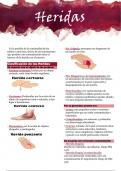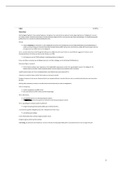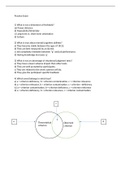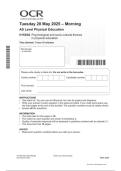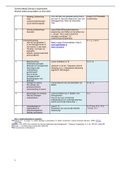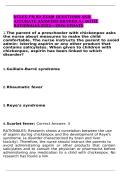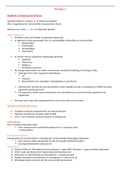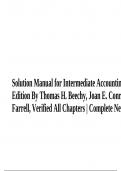Week 8
A Prevention, Early Intervention, Treatment Framework
and other environmental considerations
J.J. McWhirter Page | 1
A COMPREHENSIVE PREVENTION, EARLY INTERVENTION, TREATMENT
FRAMEWORK
What serves as treatment intervention for one problem usually serves as preventive
strategy for another more advanced problem
Factors which contribute to risk: demographic characteristics [social class +
economic conditions, family, community + school stressors] + personal
characteristics, attitudes + behaviours
As risk factors increase without concurrent increase in protective factors, children +
adolescents become increasingly likely to be at imminent risk
Protective factors: buffer/protect young people who might otherwise be at greater
risk
• Just like risk factors, protective factors are also present at individual level
(social skills + intelligence), family level (authoritative parenting + strong
attachments between child + parent) + community level (accessible resources
like social + medical services + parks, and strong linkages between family +
community)
Prevention efforts that support + maximize protective factors while reducing risk
factors are more likely to be successful
When formulating model that incorporates prevention, early intervention + treatment
– must consider:
1. Role of school
2. Linkage between problems of young people + prevention
3. Interplay between treatment + prevention
Prevention as an intervention approach
, Week 8
HISTORY OF PREVENTION PROGRAMS
➢ 1960s: drug prevention programs to provide information [emphasis on drugs
rather than why people use them]
➢ 1970s: drug prevention programs addressed personal + social factors
Page | 2
correlated with drug abuse + provide more accurate information [affective
education]
➢ 1980s: emphasized behavioural strategies [social competency + prosocial
coping – life skills]
➢ 1990s: systematic incorporation of affective, cognitive + behavioural areas +
emphasized development of both skills + prosocial attitudes
➢ 2000s: beginning of development of concern with program effectiveness
▪ Deeper insight – pages 58-60
PREVENTION DEFINED
Prevention: stop something before it happens
Caplan – categories of intervention:
Primary prevention Secondary prevention Tertiary prevention
reduction of new prevalence rates for
harmful effects of an
incidence rates of those at risk of
existing disorder
disorder developing disorder
Gordon – different classification system which identified targeted populations:
Universal prevention Selected prevention Indicated prevention
individual/subgroup of only individuals + groups
everyone in population
population at high risk
Institute of Mental Health – defined prevention efforts as only those occurring before
onset of disorder
Prevention as an intervention approach
, Week 8
Several criticisms regarding applicability of recognized definitions:
• Initially created to classify prevention efforts for physical disorders
• Institute of Mental Health definition uses disease-based model [excluding
social + political change + health-promoting interventions as part of Page | 3
prevention]
Romano + Hage – define prevention efforts as those having one or more of
following:
1. Stops [prevents] problem behaviour from ever occurring
2. Delays onset of problem behaviour
3. Reduces impact of existing problem behaviour
4. Strengthens knowledge, attitudes + behaviours that promote emotional +
physical well-being
5. Supports institutional community + government policies which promote
physical + emotional well-being
• Encompasses goals of primary, secondary + tertiary prevention + includes
prevention efforts within larger social systems + acknowledges counselors’ +
other human service professionals’ role as agents of social change
• Must determine which prevention practices + implementation strategies will be
most effective with what individuals + what communities at what time > individual
+ context-specific factors + interaction among factors in creation +
implementation of interventions
DESCRIPTION OF FRAMEWORK
Operates along several continuums + provides intervention components that
encompass society + community, family + schools
Prevention as an intervention approach
A Prevention, Early Intervention, Treatment Framework
and other environmental considerations
J.J. McWhirter Page | 1
A COMPREHENSIVE PREVENTION, EARLY INTERVENTION, TREATMENT
FRAMEWORK
What serves as treatment intervention for one problem usually serves as preventive
strategy for another more advanced problem
Factors which contribute to risk: demographic characteristics [social class +
economic conditions, family, community + school stressors] + personal
characteristics, attitudes + behaviours
As risk factors increase without concurrent increase in protective factors, children +
adolescents become increasingly likely to be at imminent risk
Protective factors: buffer/protect young people who might otherwise be at greater
risk
• Just like risk factors, protective factors are also present at individual level
(social skills + intelligence), family level (authoritative parenting + strong
attachments between child + parent) + community level (accessible resources
like social + medical services + parks, and strong linkages between family +
community)
Prevention efforts that support + maximize protective factors while reducing risk
factors are more likely to be successful
When formulating model that incorporates prevention, early intervention + treatment
– must consider:
1. Role of school
2. Linkage between problems of young people + prevention
3. Interplay between treatment + prevention
Prevention as an intervention approach
, Week 8
HISTORY OF PREVENTION PROGRAMS
➢ 1960s: drug prevention programs to provide information [emphasis on drugs
rather than why people use them]
➢ 1970s: drug prevention programs addressed personal + social factors
Page | 2
correlated with drug abuse + provide more accurate information [affective
education]
➢ 1980s: emphasized behavioural strategies [social competency + prosocial
coping – life skills]
➢ 1990s: systematic incorporation of affective, cognitive + behavioural areas +
emphasized development of both skills + prosocial attitudes
➢ 2000s: beginning of development of concern with program effectiveness
▪ Deeper insight – pages 58-60
PREVENTION DEFINED
Prevention: stop something before it happens
Caplan – categories of intervention:
Primary prevention Secondary prevention Tertiary prevention
reduction of new prevalence rates for
harmful effects of an
incidence rates of those at risk of
existing disorder
disorder developing disorder
Gordon – different classification system which identified targeted populations:
Universal prevention Selected prevention Indicated prevention
individual/subgroup of only individuals + groups
everyone in population
population at high risk
Institute of Mental Health – defined prevention efforts as only those occurring before
onset of disorder
Prevention as an intervention approach
, Week 8
Several criticisms regarding applicability of recognized definitions:
• Initially created to classify prevention efforts for physical disorders
• Institute of Mental Health definition uses disease-based model [excluding
social + political change + health-promoting interventions as part of Page | 3
prevention]
Romano + Hage – define prevention efforts as those having one or more of
following:
1. Stops [prevents] problem behaviour from ever occurring
2. Delays onset of problem behaviour
3. Reduces impact of existing problem behaviour
4. Strengthens knowledge, attitudes + behaviours that promote emotional +
physical well-being
5. Supports institutional community + government policies which promote
physical + emotional well-being
• Encompasses goals of primary, secondary + tertiary prevention + includes
prevention efforts within larger social systems + acknowledges counselors’ +
other human service professionals’ role as agents of social change
• Must determine which prevention practices + implementation strategies will be
most effective with what individuals + what communities at what time > individual
+ context-specific factors + interaction among factors in creation +
implementation of interventions
DESCRIPTION OF FRAMEWORK
Operates along several continuums + provides intervention components that
encompass society + community, family + schools
Prevention as an intervention approach

